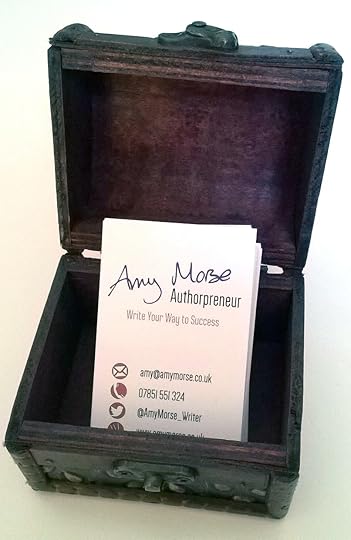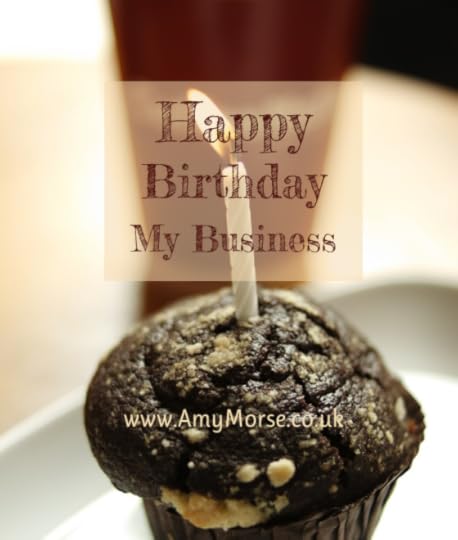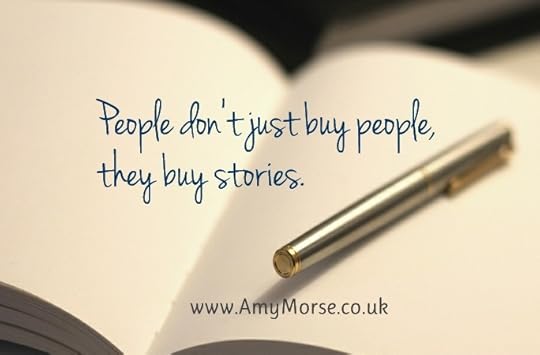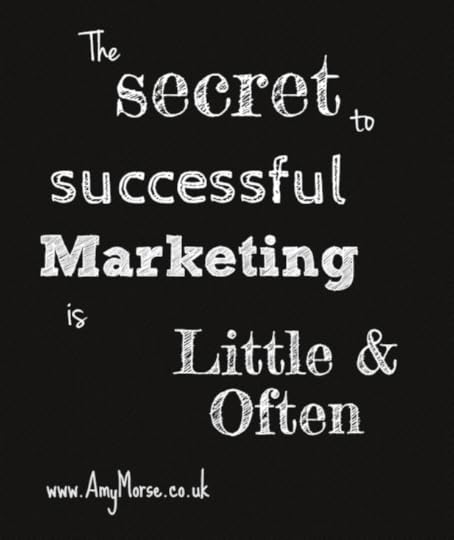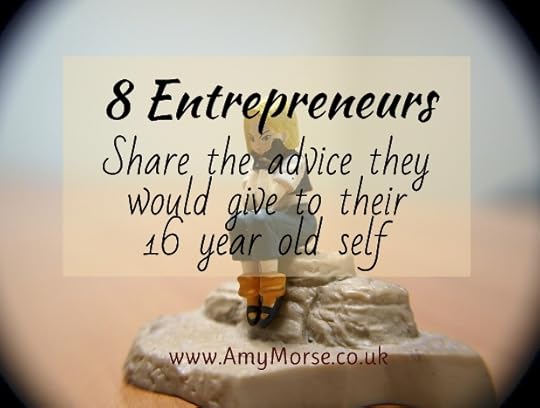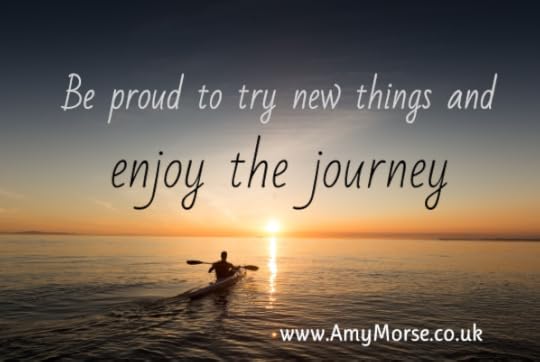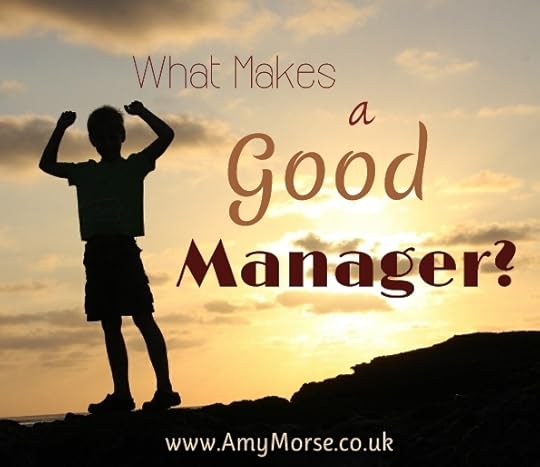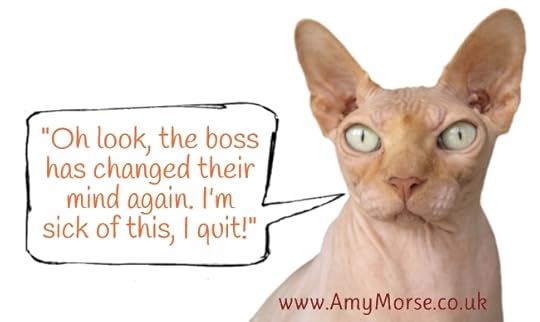Amy C. Fitzjohn's Blog, page 34
July 4, 2016
My Business Expo Checklist
On Thursday 14th July 2016 I’ll be hosting my first ever stall at a big business exhibition.
I’m both excited and terrified!
I’ve done jobs fairs and business shows many times in the past, but on those occasions I’ve always been wearing somene else’s uniform and promoting someone else’s business – and I’ve always had colleagues with me.
I’ll be exhibiting at the Business Growth Show at Colston Hall in Bristol.
Tickets are FREE and you can book them here:
https://www.eventbrite.co.uk/e/bristol-business-expo-tickets-21042948024
Please come along and visit me at the stall, I’d love the company and the support!
This just got real… in just over a week it’ll be me on my own, grinning proudly while presiding over my own trade stand. I’ll be stood in front of a roller banner emblazoned with my image and branding, persuading people to put their business cards in a box for a chance to win a bottle of plonk. I’ll be giving my spiel over and over again, and handing out all the gorgeous new postcards I’ve had printed.
With a bit of luck I may even sell a few books!
I want to be well preared for the event, and I love a list (I wrote a blog on my ‘World of Lists’ last year).
Planning ahead, to ensure I order enough bits and bobs from my favourite local printers, Brunel One , I’ve started a checklist for my stand.
I’m sharing it to help other small businesses exhibiting at their first show, and to ask any businesses who have more experience of attending shows if there is anything they think I should add to the list.
Comments and feedback welcomed and hope this is useful to you:
Roller banner Bottle of Plonk (for business card prize draw) Vase / box for the business cards prize draw Tablecloth Sweets and a nice bowl for them (I may even make some cake bites the day before if I have time) Postcards (I’ve had some beautiful postcards produced with my service packages on the reverse)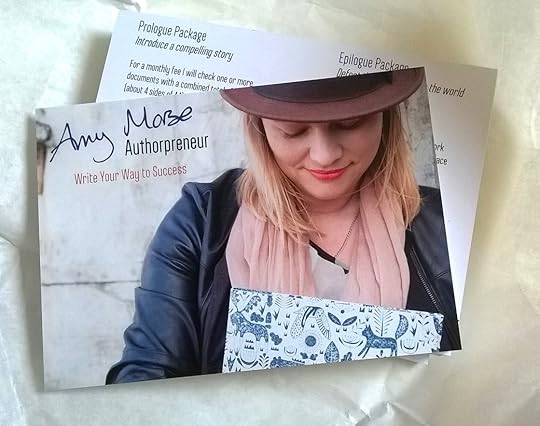 Business Cards and something to put them in (I have a mini ‘Bronze Box’ I use to display them) Laptop (remember charged and mouse) Phone (fully charged) Display box of my books (my big ‘Bronze Box’) Spare copies of my books to sell Cash tin with change Sign up sheet – I’m working on a new book ‘Blogging for Business’, it’ll be out in August. I plan to collect the email addresses of anyone interested so I can send them the link when it’s published Pens Paper Notebook My diary
Business Cards and something to put them in (I have a mini ‘Bronze Box’ I use to display them) Laptop (remember charged and mouse) Phone (fully charged) Display box of my books (my big ‘Bronze Box’) Spare copies of my books to sell Cash tin with change Sign up sheet – I’m working on a new book ‘Blogging for Business’, it’ll be out in August. I plan to collect the email addresses of anyone interested so I can send them the link when it’s published Pens Paper Notebook My diary Am I missing anything?
June 16, 2016
To Freebie, or Not To Freebie… That Is The Question
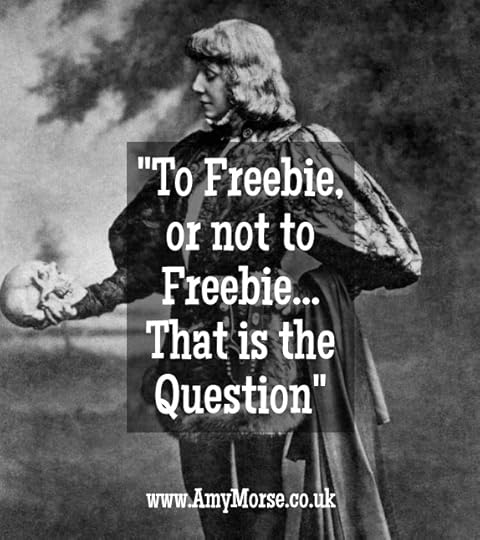
When should you offer a freebie?
…I’m a writer so I love a Bill Shakespeare pun!
It’s a tough one, isn’t it? As entrepreneurs we rue the fact that we do so much work with no financial recognition, all on the premise that eventually it will pay off.
We bemoan those cheeky folks that take advantage of our goodwill and squeeze every ounce of free advice from us they can get.
We tell ourselves it’s worth the risk, because we can’t help but love what we do.
 I’ve wrangled with this dilemma for a while. I already seem to drink copious amounts of coffee with people, help them with their challenges then it never converts to a sale.
I’ve wrangled with this dilemma for a while. I already seem to drink copious amounts of coffee with people, help them with their challenges then it never converts to a sale.
You may argue that I’m not being assertive enough, or that I’m my own worst enemy, but I would counter that this has been an important learning experience and has grown my network. As a result, I’ve learned that…
Doing things for free is fine, as long as you are strategic about it (Tweet This)
I’ve recently joined Near Desk. It’s a national Pay-As-You-Go hotdesking ‘club’ with multiple locations in Bristol alone. I’m especially fond of Desk Lodge and work there from time to time for a change of scenery, some company (and the tasty coffee)!
Sometimes I just like the ‘feeling of going to work’ and that alone is often enough of a motivator to kick my productivity up a notch (brilliant when you are as accomplished a procrastinator as I am!).
I’ve just spent my first day working out of Desk Lodge offering a FREE business support drop in service to help businesses with their writing challenges.
On my way home, I went via castle park and shot this short video:
http://authorpreneur.amymorse.co.uk/wp-content/uploads/2016/06/DeskLodge-DropIn-Video-1.mp4
I’ll be running FREE business support drop ins at Desk Lodge on the third Thursday of the month. I recommend booking via Eventbrite, then we can exchange emails to agree a time and do some prep ahead of the meeting.
BOOK HERE – The next session is on Thursday 21st July from 10am to 2pm.
If you’re being asked to do things for free, or if you are wrestling with a decision about whether or not to offer a free ‘hook’ to prospective customers, check out my quick and simple ‘test’…
Download my (non-financial) ‘Cost Vs Benefit’ crib sheet. No poring over your accounts or doing any difficult maths, I promise! This ‘test’ relies on you being able to add up 1s, 2s and 3s (simples!).
Download my ‘Cost vs Benefit Crib Sheet’ HEREIf you find this crib sheet useful, treat me to a thank you coffee by adding to my ‘Caffeine Kitty’ via PayPal. Thanks


‘Caffeine Kitty’ wishes you a purr-fect day 
June 9, 2016
USP is so Passé, What’s Your SSP?
Redirected from LinkedIn: Download the The Story Of Your Business Questionnaire
(This post will take approx. 5 minutes to read)
If you’ve ever been to any business workshops or events the chances are that at some point someone has asked you “What’s your USP?” (Unique Selling Point).
I’ve always hated that question. Not because I couldn’t fudge some satisfactory answer to it, but because it’s meaningless.
Of course you’re unique, you’re a human!
Unless you’ve invented something ground-breaking, most of us can’t honestly say that our business and the work we do is completely unique. It’s hard to even say we do things in a unique way; just by the law of averages and attrition, the chances are, someone else, somewhere in the world, does what you do and does it in a similar way.
The only thing you can absolutely, 100% guarantee, that’s unique about your business is YOU; and the thing that makes you YOU is your STORY.
No two people’s stories are ever the same, even siblings will remember different things that impacted their lives, moments of joy and moments of despair. If you ever recount a childhood memory with a sibling, they will probably remember something different to you, because we all have different ways of perceiving things.
Those three letters U S P have been so overused in business now they have become a cliché; but when we ask someone that, what are we really asking?
We want to know why X business is different to Y business, when on the face of it they seem to do the same thing.
Perhaps DSP (Different Selling Point) is more accurate? Perhaps we should be asking: “What’s your DSP?” At least that means something?
But it’s more than that, it’s your SSP – your Story Selling Point – that will keep people curious.
A truly compelling story will provoke an emotional reaction from us. Whether the story makes us laugh, makes us cry, makes us empathise and feel as though the story teller is speaking directly to our own hearts – if we react, we act.
A good story has a character, an action and a resolution; a great story has heroes and villains, it has conflict, it has us rooting for the hero, it has thrills and spills and, I know it’s a cheesy, but it has a happy ending, where our protagonist improves or grows themselves in some way (beat the bad guys, save the world).
The problem with USP and DSP is that both are about you and your business, rather than the people that turn your brilliant idea into an actual business – your customers.
The story of your business is not just a sequence of events that got you from idea to market – customers want to know what’s at the heart of your business.
What compels you? What moves you? What was it that sent you down the path you find yourself on and where are your going from here? Was there a single inciting incident somewhere in your past that motivated, inspired, scared or encouraged you?
That’s the story of your business and the key to finding your Story Selling Point (SSP) to draw in the curious, start a conversation and build the relationship so that they choose you and not an alternative service.
I’ve been writing and telling stories all my life, and they are at the heart of everything I do.
I now help small businesses write their way to success, by telling their story in their own words.
I’ve also written and published four thriller novels and have more on the way (did I mention.. I love a good story!):
So what’s the story of your business? What’s your SSP?
Download the The Story Of Your Business Questionnaire and I’ll take you on a journey of self-discovery to draw out the story of your business and nail that SSP.
After all, people don’t just buy people, they buy stories.
D o you enjoy my blog updates? My creativity is fuelled by coffee, thank me by helping replenish my coffee fund and donate via PayPal. Thanks!
o you enjoy my blog updates? My creativity is fuelled by coffee, thank me by helping replenish my coffee fund and donate via PayPal. Thanks!

Get instant updates to your inbox when I publish a blog: Follow me on Bloglovin’
June 1, 2016
Surviving the First Year in Business
Entrepreneurship has always been in my DNA; I’ve been part time self-employed for many years, but it was only in 2015 that I found the confidence and got the push I needed to go for it and fully employ myself.
I started my business a year ago today (1st June 2015).
Happy Birthday My Business!
The first few months were spent piloting ideas and building a business plan with the help of a mentor, but to me, it’s been a year since I broke the shackles of employment and became fully self employed.
It’s been a steep learning curve and it’s been tough, and to a certain extent, still is.
If you tried to run on a treadmill, whilst juggling, on a roller coaster, I imagine the feeling would be similar to running your own business!
The rewards, however, are worth it. Not necessarily the financial ones – although when you get them, they can be lucrative – but it’s all the small things.
These are the things I love about self-employment:
For me the biggest reward is freedom. I can embrace the day and do random things like: be a regular guest on BBC Radio Bristol midweek in the afternoons. Sitting in the park in the sunshine, surrounded by notebooks, concocting and enacting ideas and plans Having an intimate knowledge of all the best coffee shops in the city and a wallet full of loyalty cards. I never imagined I’d spend so much of my life working in coffee shops, in fact, as I drafted this post I was sat in the Watershed with a pot of tea. Getting free booze and food at events while meeting really fascinating, inspiring and inventive people in the business community, and learning from them. Doing skills trades with other entrepreneurs and experiencing some innovative new services. Dictating the time I start work – I’m rarely out of my house before 9am these days Allowing myself the time during the day to prepare tasty healthy meals, instead of nipping to the corner shop in my lunchbreak for a sweaty sandwich to eat at my desk. Choosing who I work with Feeling like a full member of my communitySounds great doesn’t it? But it’s not all sunshine and cappuccinos. Working for myself has also been frustrating, confidence crushing and even humiliating at times.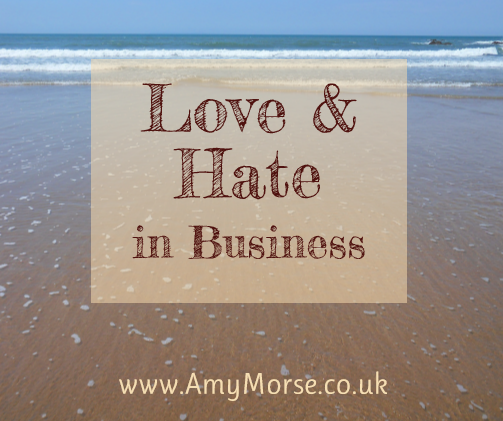
Here are the things I hate about self-employment:
Wondering when the next chunk of money will arrive in my bank account Clients sending work to me at the last minute, often a weekends or in the evening Still sitting at my computer sifting through emails until late at night Business events always seem to be in the evenings when I’d much rather be snuggled up on the sofa in my Jim-jams with my husband and the cat, binge watching a box set Family members constantly asking if we’re okay for money or when I’ll get a proper job The guilt of having to rely on my husband’s wage in the months when I don’t make much money. Waiting for months to get paid a few quid that means nothing to a business but to me it means the difference between eating leftovers from the fridge or going out at the weekend and indulging in the wonderful culinary delights on offer in Bristol. Not being able to afford a holiday when my long suffering husband desperately wants a weekend away in the sun Technology failing on me at the worst times Some days I feel like a fraud because I rarely follow my own advice and do the things I recommend to my clients!Despite it all, my business has survived and I have thrived. I can’t imagine working for someone else now, the very idea sends a cold shiver through me – best get my finger out and start earning more money so I never have to go back to being a wage slave!
What’s the one thing you love most, and what’s the one thing you hate the most about being in business?Get a notification whenever I publish a new post – Follow me on Bloglovin’
May 26, 2016
In business, sometimes you just have to let go…
(This post will take approx. 5 minutes to read)
I’ve always had an entrepreneurial streak.
I have a childhood memory of our mum paying for a stall at a craft fair one weekend so that my brother, sister and I could sell some of our homemade crafts. In effect, mum was our angel investor; she got peace and quiet on a Saturday, and we got to keep any money we made. I must have been about 10 years old.
Later, I had a lucrative little business babysitting for the teacher’s kids, I was 14 or 15 (I was clearly quite a responsible youngster, being the oldest of 3).
When I finished school in the early 90’s, I did the safe and expected thing and got a proper job.
Enterprise was never presented to me as an option. In fact, as a girl growing up in small town Somerset, the expectation was that I would get a job for a bit then get married and have babies and this was my place in life. The only expectation of me was that I raised good kids and was an obedient wife.
Well… that’s really not my style, and it took me many years to admit that to anyone. While I quietly harboured crazy dreams of travelling and writing and working for myself, instead of fading away behind my children and growing into a shrivelled, little, unfulfilled wallflower!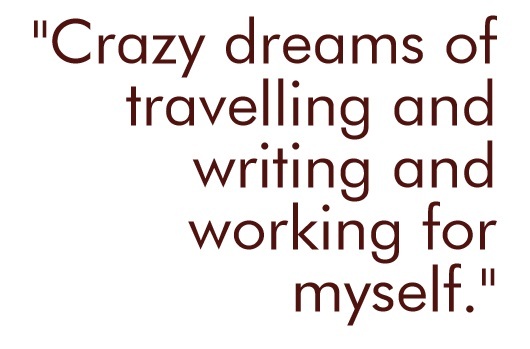
I let that option for my life go a long time ago…
I first dabbled in the mysterious realms of self-employment back in the early noughties. I had a comfortable job supporting long term unemployed people into work, 9 to 5, Monday to Friday – but something was missing.
I started to paint again. I’d turned my back on art after having a fundamental difference of opinion with an art lecturer at college; I wanted to learn about art, he wanted me to paint what the examiners liked so I could pass the course. Needless to say, I skived his lessons, failed, and for years believed I couldn’t paint for toffee.
I let those doubts go and I hung my big, bold, canvases of flowers (very Georgia O’Keefe) all over the house. Visitors made positive comments and a friend said: “You should have an exhibition!”
So I did.
And people bought my artwork.
Sometimes for hundreds of pounds.
I thought “I should probably tell the taxman about this” – I registered as self-employed and so ‘Tom Cat Designs’ was born.
Tom Cat Designs was my first business. The trouble is, I never thought of it as a business. To me, it was only ever a hobby that made some welcome extra cash. As a consequence, I never did any of the things I talk to my clients about to make it sustainable and then grow it as a business. I wasn’t taking it seriously and I wasn’t investing, time, energy and money into it. It fizzled out; it failed.
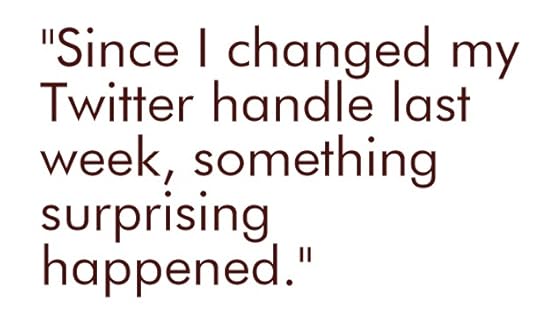 At the time, the only real marketing I did was to set up a Twitter account and a website for Tom Cat Designs.
At the time, the only real marketing I did was to set up a Twitter account and a website for Tom Cat Designs.
As I had the domain name ‘tomcatdesigns.co.uk’ it became my email address and it stuck.
At the time, having @TomCatDesigns as a Twitter handle made sense, and for me it was a reminder of where my adventure into entrepreneurship began.
But now is the time to let it go.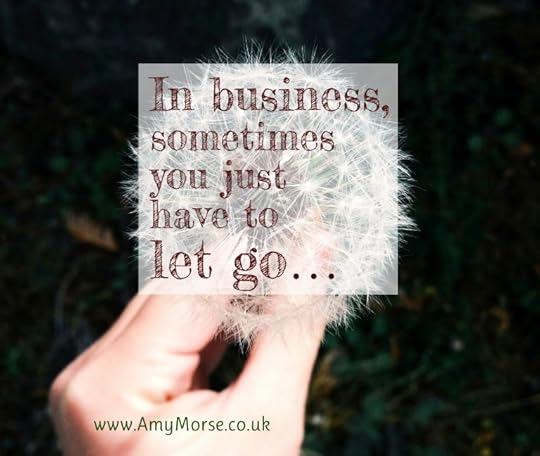
It was getting tedious telling the story of why my email and Twitter handle were Tom Cat Designs, and now I’m telling it for the last time.
I’m letting it go.
My new Twitter handle is now @AmyMorse_Writer and my new business email address is amy@amymorse.co.uk
Since I changed my Twitter handle last week, something surprising happened.
I saw a surge in new followers.
For a long time I’ve had a consistent follower rate of maybe 20 – 30 new followers each week and 10 unfollwers (mostly people farming my address and unfollowing me when I didn’t follow back!), but in the first day of my new Twitter handle I had 35 new followers. For the next few days I saw an increase of similar levels, and although the rate of new followers has levelled out this week, it’s still going up.
I asked myself why and dug deeper.
Here are the 3 reasons letting go of my old identity and embracing a more personal brand is getting me noticed on Twitter:
1) My @ handle is my name and not a faceless business, existing contacts can find me easily now 2) My @ handle says something about what I do, naturally attracting people who are interested in writers 3) Fresh and new; people are curious when they see something shiny and newIf you’re still clinging on to a sentimental old Twitter name change it up, let go of dusty old labels and embrace what makes you YOU. Trust me, far from mourning the passing of Tom Cat Designs, I feel much more grounded in what I really do – writing!
May 13, 2016
4 Content Marketing FAQ’s
(This post will take you about 5 minutes to read)
With my background in skills training, business support and writing, I help small businesses write their way to success. I’m regularly asked to speak, train and present on the nuances of content marketing, with my writer’s eye for storytelling.
I run workshops on blogging, boosting your business with a book, SEO and occasionally social media content (among other topics) – areas all dependent on generating great content and telling a story that your customers will love.
After all, people don’t just buy people, they buy stories.
There are a few questions that regularly crop up – here’s 4 of my Frequently Asked Questions about content marketing:
1) What’s the ideal length for a blog post?
There are two schools of thought on this: either, blog little and often, or create long blog articles stuffed with keywords.
There is a mounting body of evidence that 3,000+ words articles are popular; but writing a dissertation regularly is a big ask for most of us!
Personally, I believe 500 – 1,000 words is ideal.
Less than 500 and it’s difficult to tackle a topic in any meaningful depth, more than 1,000 takes too long to read if you’re busy and readers will either skim through or give up part way.
2) How do I know if people are reading my blogs?
Think about your behaviour when you read blogs – how often do you comment?
Don’t be disheartened if people aren’t commenting – most of us don’t – it doesn’t mean no one is reading what you’ve written. The only way to know is to look at the stats.
Depending on what platform you use to blog on, make yourself familiar with the analytics, all the major platforms (i.e. WordPress) allow you to monitor your stats.
You can also monitor how many retweets, repins, likes and shares you get on social networks.
Another way to see if your content sharing is working is to look at your rank on Google. Are you on the front page (or close to it)?
I’ve compiled a quick ‘Search Engine Optimization (SEO) Audit Checklist’ printable
Download it here: SEO Audit ChecklistPDF
If you find it useful, please show your appreciation by donating to my coffee fund via PayPal  (Thanks!)
(Thanks!)

However, none of this guarantees that people have read the whole blog post, or that they are likely to convert to a customer.
Ultimately, when you post things on social media and blog regularly, these are all small things you can do to raise awareness of your product and/or service – marketing is an inexact science but the secret is ‘little and often’.
Keep going, be in lots of places regularly sharing valuable, interesting and entertaining content and the sales will look after themselves.
This is how I’ve managed to sell over 5,000 eBooks in under 3 years.
3) How often should I blog?
There’s no right or wrong answer other than to avoid ‘feast or famine’, and be consistent.
Ultimately, the decision is down to your personal preference; the time you can set aside (or budget you have to pay for writers), what ‘the norm’ is in your sector, but most importantly: what your customers expect.
If you are new to blogging, build it in gradually. Perhaps start by publishing something once a month, find your rhythm and work on your writing craft. It’s far better to write one really well considered thought leadership piece a month than churn out rubbish every day.
Quality not quantity.
As you get used to it, get quicker, more skilled and more confident, aim to publish something weekly.
If you need some ideas, get my list of 120 blog ideas HERE
4) What if we’re in a boring industry, what can we talk about?
If your business does something functional and not particularly sexy, it can be tough to come up with interesting things to talk about on a blog and social media. Instead, think outside the scope of what you do and talk about something related to your industry that your customers will be interested in. Develop a theme around that.
Put yourself in your customers shoes. Ask yourself why they buy your products/services? How can you ‘edu-tain’ (educate + entertain) them about your business?
Here’s a few examples and suggestions for themes for content to create and share for businesses that aren’t always easy to get excited about:
Insurance: The stupid and frivolous insurance claims people make
Health & Safety: Ridiculous examples of health & safety or tackle some H&S facts and fiction (i.e. Do kids need to wear safety googles when playing conkers?)
Picture framing: Colour matching, picture hanging tips and arrangements, unusual things people put in picture frames, tips to mount your images etc.
Insulation: Why do people have insulation? To save energy and stay warm. You could talk about the latest innovations in Eco-design, passive living, hi-tech materials in construction and energy saving tips etc.
Challenge me!Go on, give it a whirl…
Tell me in the comments what your business is all about and I’ll suggest a theme for content you can create and share.If I can’t think of an idea for you, I’ll send you a FREE eBook (choose between these books):
Any book in the Sheridan and Blake Series or Authorpreneuer Almanac
For notifications each time I publish a blog:
For inspiration and updates direct to your inbox, sign up for my monthly newsletter
April 27, 2016
Advice to your 16 year old self – part 2
A few weeks back I shared the one piece of advice I would give to me 16 year old sel f:
f:
I posed this question to other entrepreneurs on the blog and on social media and received lots of fantastic responses back.
Here’s 8 of the best of them:
Maggie James, successful author of 6 suspense fiction books (read my recent interview with her HERE):
“Most 16 year old’s have all the swagger, and I was no different, but underneath I had no confidence in myself and my writing.
I’d say go for it, believe in yourself, and just do it. Don’t wait for years to get writing.”
Hali Jafari of Truly Nourished
“If I could tell my 16 year old self one thing, it would be to be Brave! Be brave and confident in the decisions you make, stop second guessing everything and stop worrying about what others think or say…. Just be Brave!”
Rob Carter, Action Coach
“There’s only one failure and that’s the failure to participate”
Claire Stone of Claire Stone Nutrition
“Don’t worry about the fact that you think differently. It’s ok to be exactly who you are without approval of other people.”
Joanna Trendall of Trendall and Scott
“Believe in yourself – and don’t be afraid to ask for help!”
Eli Trier, Artist and Writer
“Don’t bother trying to fit in. You were born to stand out. “
Kellie Sanfiz of Crystabella Accesories
“Your thoughts become your reality”
John Bradley, Writer
“Go to more parties!”
I interviewed John, the man behind the Creme Egg, at Easter – read it HERE
In the interview the advice he shared for his 16 year old self was:
“Work harder.”
What advice would you give to your 16 year old self?(I may even do a part 3 if I get some interesting comments!)
Never miss an update, Follow me on Bloglovin’
or SUBSCRIBE
Help keep me fueled with coffee…

April 20, 2016
Business is a Journey not a Destination
Working for yourself is a journey rather than a destination, however, we often reach way points on that journey.
I’ve just reached a turning point in my business, and the culmination of a journey that started for me back in 2010 when I had the spark of an idea for a series of books, that later became the Sheridan and Blake Adventure Series.
I’m marking the occasion with a video blog, because this is a turning point for me and my business
I’m sad to say goodbye to Tom Sheridan and Sasha Blake, they’re like old friends to me – old friends who will always be in my thoughts but have moved on and so must I…
… Back to writing!
Never miss an update! Follow me on Bloglovin’
Do you enjoy reading my blog updates? Show you’re appreciation and help feed my coffee habit by donating here… (Thanks x)

April 13, 2016
What Makes a Good Manager?
I’ve seen some colourful content butterflies flitting around the inter-webs recently on what makes a good manager.
This one – by the Chartered Management Institute – caught my eye:
I’m going to keep politics out of this because I believe it can be a dangerous contaminant in the workings of a business.
I have my own political views, and it’s fair to say they are left of centre – but my blog is about writing and entrepreneurship, not politics.
Donald Trump on Management: Not As Dumb As You’d ThinkThe three key points the post makes for Trump’s strengths as a Manager are:
He’s Impervious to Criticism He’s Unpredictable He’s a Man of The PeopleLet’s take a closer look..
1. He’s Impervious to Criticism
Love him or loathe him, it’s fair to say Trump has had a lot of negative press coverage, especially over here in the UK and Europe where he has been openly scathing about the freedom of movement of workers and the freedom of people to practice their religion. He’s the butt of many jokes and a satirists dream come true.
The post sums it up well: “Chronicling all his wacky remarks, blunders, outrageous proposals, and, of course, crazy tweets of this past year would be nearly impossible. But the constant critique has failed to make him docile.”
The post goes on to say: (Trump’s) “a great example on how to be resilient to criticism, maintaining self-belief in himself and his team”
But is this necessarily a positive trait in a business?
Well, Yes and No…
When you work for yourself, or start a new venture, it’s inevitable that you’ll leave yourself open to criticism. There will always be nay-sayers. You’re changing the status quo and people struggle with change.
If people are excited by a change there is a high likelihood they’ll accept and embrace it, if the change scares them, they are more likely to resist it.
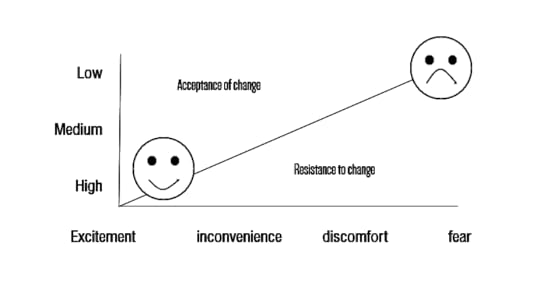 There’s a fine line between self-belief and arrogance (Trump crossed that line long before he ever ran for political office).
There’s a fine line between self-belief and arrogance (Trump crossed that line long before he ever ran for political office).
It’s one thing to have faith in what you do, but something else to charge ahead, steamrollering through everyone and everything to get your own way with no regard to the damage you’re causing to everyone around you and your own reputation.
There’s self belief, then there’s living in denial.
Listening to criticism is an essential part in the process of improving the quality of your offering and building your own personal skills.
For example, in writing critique groups I ask others to tell me what’s wrong with my work so I can take steps to improve it. Unless you are aware of your shortcomings, how will you improve?
2. He’s Unpredictable
One of the best things about small businesses is their ability to be agile – to break, change and shape the rules.
In the post, the argument is for: “Keeping supporters interested and motivated, constantly giving them something new and fresh to think about and to throw their support behind.”
While this might get you noticed in the short term, as a business, you don’t want a reputation for being fickle and unreliable.
As a writer, I know the power of keeping the momentum up, building tension and throwing in new and interesting twists but ultimately, all action and no substance makes for a poor and unsatisfying book.
The basic formula for a story is:
Character + Conflict = Story
but ultimately the character must grow or change in some way, otherwise what’s the point?
In business, new ideas, fresh thinking, constant change is good… to a point – but there needs to be some stability or it will never be sustainable – frankly, everyone will get bored or exhausted and go elsewhere.
“Oh look, the boss has changed their mind again. I’m sick of this, I quit!”
3. He’s a Man of The People
I promised I wouldn’t make this political so I’ll refrain on commenting on the type of people likely to vote for Trump…
He’s a man for his type of people, would be a more accurate statement.
One thing you can say about Trump – he knows his target audience!
He knows his niche extremely well and knows just what to say and do to rally them around him and keep them coming back for more.
On this, I with Chartered Management Institute.
Trump has identified a ‘target customer’ and a ‘gap in the market’ extremely effectively.
The key to building a successful business is to build it around your customer. Know your number 1 fan and do everything in your power to be their perfect match.
Knowing the ‘Emotional Selling Point’ for your target customer is key to appealing to them on a deep level – “Trump has figured out what American voters want to hear – not what they say they want to hear but what they really want to hear.”
I appreciate that I’ve looked at this article by the Chartered Management Institute from the perspective of a business, and not from a manager’s point of view, however, whether you’re running a business on your own, managing staff or running for office, ultimately at the heart of everything is the people you’re serving.
Personally, I can’t think of a worse person to have as a boss than Donald Trump (possibly with the exceptions of Kim Jong-un or Robert Mugabe) – not only because I’m a female and I know Trump would only have given me the job based on my cup-size – but because being a good manager is not about massaging your own ego, it’s about nurturing, supporting and growing the people around you.
I’d want to work for a ‘Leader’ not a ‘Manager’ and I aspire to be a good leader to the people working for me in the future.
To quote one leader that I would quite like to work for (although I’d still rather work for myself!), Richard Branson:
“Train people well enough so they can leave, treat them well enough so they don’t want to” Follow on BloglovinApril 7, 2016
Advice to your 16 year old self – Part 1
I was an introverted and weird teenager.
I wrote bad, angst fueled poetry and smelled of incense. I made questionable fashion choices that involved colourful tasseled skirts and hiding in massive unflattering jumpers. While everyone at school was listening to Spice Girls I was listening to Clannad – I stand by my eclectic music choices; I still hate the Spice Girls and occasionally listen to ethereal Celtic folk music (although right now I’m listening to Chase and Status!).
For years, I was part time self employed. In fact, I was always encouraged to be entrepreneurial by my parents.
My first ‘business’ was a lucrative side hustle babysitting for the teacher’s kids. Maybe the poetry and folk music made me more trustworthy than the average 16 year old girl in Wellington, Somerset? It was my USP!
My first ‘official’ business was years later: Tom Cat Designs (Hence my Twitter handle and email address!). When I do embark on random acts of creativity I still do it in the guise of Tom Cat Designs.
Like so many young people, as a teenager, I didn’t have the confidence to pursue self employment as a serious career – it wasn’t even on the radar.
As a girl, growing up in small town England in the 80’s and 90’s, expectations for me were low. The fact remained, most of the girls in our town would leave school and have babies (often they were pregnant before leaving school) and maybe work part time in a local shop. Most of the boys were being groomed to work at one of the two major employers in town – an aerosols manufacturer and a mattress manufacturer. Of the class of ’93 leaving Courtfields Community School, I think only 5 girls went on to go to University (I was one of them, but didn’t stay – long story, and one for another time!).
So when I first heard about Young Enterprise, I jumped at the chance to volunteer.
Young Enterprise is a fantastic scheme that takes the expertise of professional business people into schools. It introduces the the idea of running a business as an option at that crucial stage where teenagers are being expected to make decisions about their careers. It provides them with the opportunity to give enterprise a go, they even earn money and compete for recognition.
Seeing the young people empowered to grow in confidence, explore their own creativity and develop their business skills is fantastic.
Making those big career decisions is scary for young people; I don’t know about you, but as a teenager I was crippled by the the indecision of what jumper to wear so I wouldn’t get noticed or bullied, and by whether or not I should talk to a boy!
Being told that I had to decide what I’d do for the rest of my life by teachers and careers advisors just did not compute.
I remember having a panic attack at one stage because I was scared I wouldn’t get good enough grades to go to uni and I’d be a giant failure forever!
… Did I mention, I also had (and still do) and overactive imagination!
(I was always going to end up being a writer!)
Everything is massive and daunting when your hormones are raging all around your body (hence the poetry therapy!).
Speaking at my first Young Enterprise event last year, and being a judge at their trade fairs, I can’t help but wonder what would have happened if I’d have had such an amazing opportunity and that kind of support as a teenager.
For too long, ‘self employment’ and ‘business’ have been veiled in a smokescreen of suits! I’m a firm believable that enterprise should be accessible, and it should be encouraged and supported.
Business is serious but it doesn’t have to be scary (Tweet this)
So, if I could offer one piece of advice to my 16 year old self, it would be:
Embrace your weirdness, it’s what will make you interesting and successful in the future.I asked my network of self employed friends and business buddies this question, and in part 2 I’ll share with you what they said…
What about you? If you could offer 1 piece of advice to your 16 year old self, what would it be?Tell me in the comments, and I may even feature you in part two!
Follow on Bloglovin
Like my blog posts? Get 52 of my best bits of inspiration on writing and entrepreneurship in this eBook:



